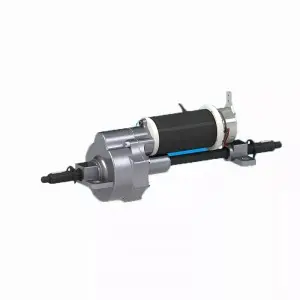How to Prevent Electric Transaxle Overheating
Electric transaxles are crucial components in modern electric vehicles, and overheating can lead to significant damage and operational issues. This blog post will explore various strategies and best practices to prevent electric transaxle overheating, ensuring the longevity and reliability of your vehicle’s drivetrain.
Understanding the Causes of Overheating
Before diving into prevention methods, it’s essential to understand what causes electric transaxles to overheat. Common causes include:
Overloading: Operating the motor beyond its rated capacity can cause excessive current draw and heat generation .
Poor Ventilation: Blocked or insufficient airflow around the motor prevents effective heat dissipation .
Electrical Issues: Voltage imbalances, low voltage, or high harmonic distortion can lead to inefficiency and heat buildup .
Friction and Mechanical Failures: Worn bearings, improper lubrication, or misaligned components increase friction and heat .
Environmental Factors: High ambient temperatures, humid conditions, or dusty environments can reduce the motor’s cooling efficiency .
Frequent Starts and Stops: Repeated start-stop cycles prevent the motor from dissipating heat, leading to gradual temperature rise .
Strategies to Prevent Overheating
1. Enhance Heat Dissipation
Improve Ventilation: Increasing the airflow around the motor transaxle by installing additional fans or vents can significantly improve heat dissipation .
Utilize Heat Sinks: Implementing heat sinks with larger surface areas or higher thermal conductivity can efficiently transfer heat away from critical components .
Consider Advanced Cooling Methods: Employing innovative cooling technologies, such as liquid cooling or heat pipes, can provide even more effective heat removal .
2. Optimize Environmental Conditions
Ensure Adequate Ventilation: Operate the motor transaxle in a well-ventilated environment with sufficient airflow to prevent heat buildup .
Maintain Optimal Temperature: Avoid operating the drive bridge in excessively high ambient temperatures, as this can exacerbate overheating issues .
3. Manage Motor Load
Operate Within Rated Load: Ensure that the motor load does not exceed the rated capacity of the drive bridge to prevent excessive current draw and heat generation .
Implement Load Sharing: Distribute the load across multiple drive bridges when possible to reduce the thermal load on each individual unit .
4. Regular Maintenance and Inspection
Perform Routine Cleaning: Regularly clean the drive bridge and its cooling system to remove dust and debris that can obstruct airflow and impede heat dissipation .
Inspect for Damage: Conduct regular inspections to identify and promptly address any signs of damage or wear to the drive bridge components, especially those related to the cooling system .
5. Implement Safety Mechanisms
Install Temperature Sensors: Monitor the temperature of critical components within the drive bridge using sensors .
Utilize Overheat Protection: Implement an overheat protection system that automatically triggers a shutdown or reduces the motor load when temperatures reach unsafe levels .
6. Optimize Control Algorithm
Reduce High-Load Operation: Modify the control algorithm to minimize the duration of high-load operation or reduce the commanded motor power during these periods .
Implement Adaptive Load Management: Develop an adaptive load management strategy that dynamically adjusts the motor load based on the drive bridge’s operating conditions and thermal capacity .
7. Upgrade Drive Bridge
Consider Higher-Performance Models: If necessary, upgrade to a higher-performance drive bridge with improved heat dissipation capabilities and a higher load capacity to mitigate overheating risks .
Real-World Examples and Case Studies
Case Study 1: Early Detection and Prevention
A fleet of electric delivery vans experienced intermittent oil leaks in their electric transaxles. Upon investigation, it was discovered that the seals were degrading prematurely due to the use of an incompatible oil. The fleet operator switched to a high-quality, temperature-resistant oil recommended by the vehicle manufacturer and implemented a more frequent inspection schedule. This change significantly reduced the incidence of oil leaks and extended the life of the transaxles .
Case Study 2: Design Improvement
A manufacturer identified that the seals and gaskets in their electric transaxles were wearing out faster than expected due to uneven stress during assembly. They redesigned the assembly process to ensure proper alignment of components, reducing stress on seals and gaskets. This design improvement led to a significant reduction in oil leakage and overheating issues .
Conclusion
Preventing electric transaxle overheating requires a comprehensive approach that includes enhancing heat dissipation, optimizing environmental conditions, managing motor load, regular maintenance, implementing safety mechanisms, optimizing control algorithms, and upgrading components when necessary. By adopting these strategies and best practices, you can significantly reduce the risk of overheating and ensure the reliable and safe operation of your electric vehicle’s drivetrain.
Implementing these measures not only extends the lifespan of your electric transaxle but also enhances the overall performance and safety of your vehicle. Regular monitoring and maintenance are key to identifying and addressing potential issues before they lead to significant damage. By staying proactive and informed, you can keep your electric transaxle running smoothly and efficiently for years to come.
Post time: Feb-28-2025


